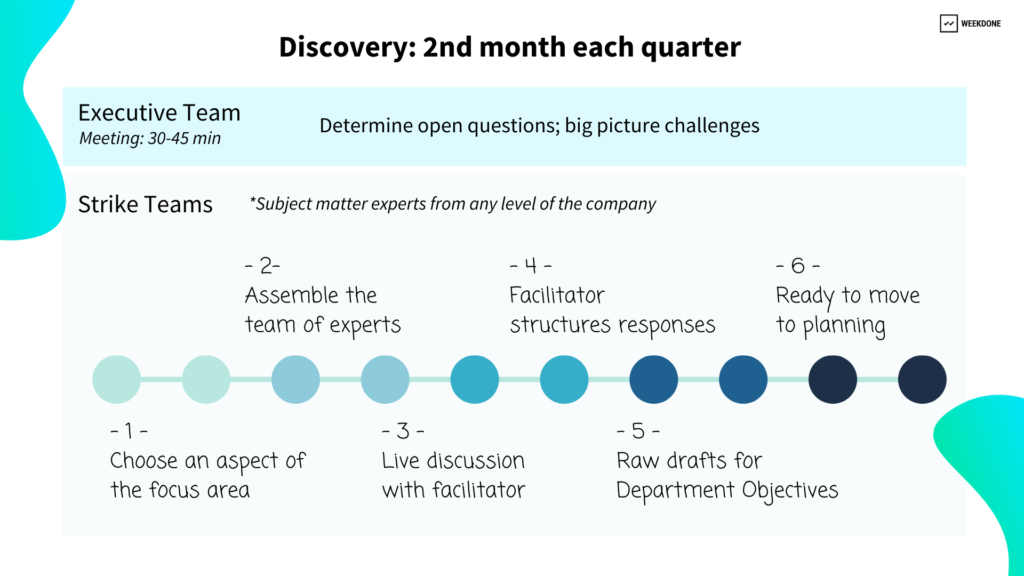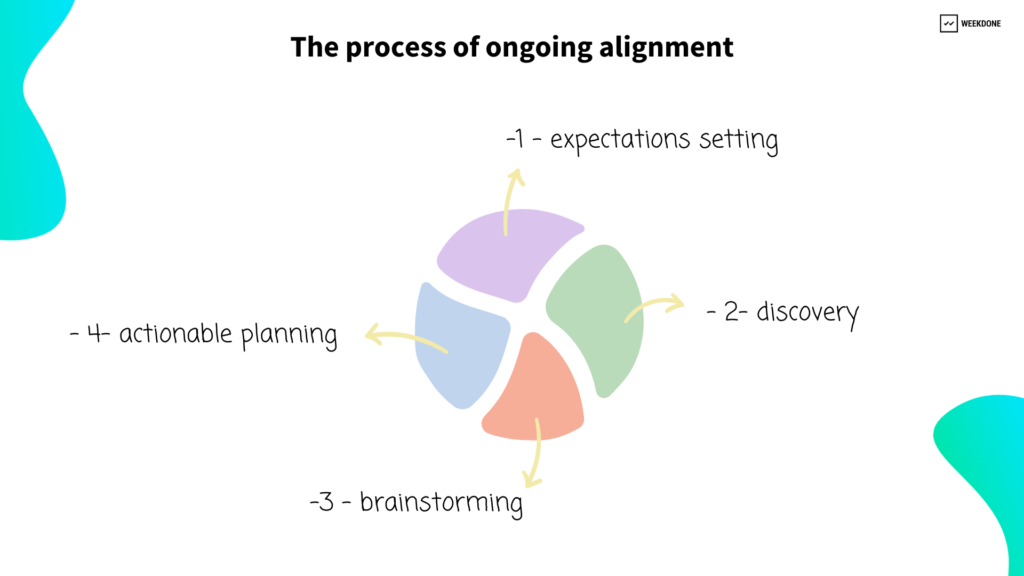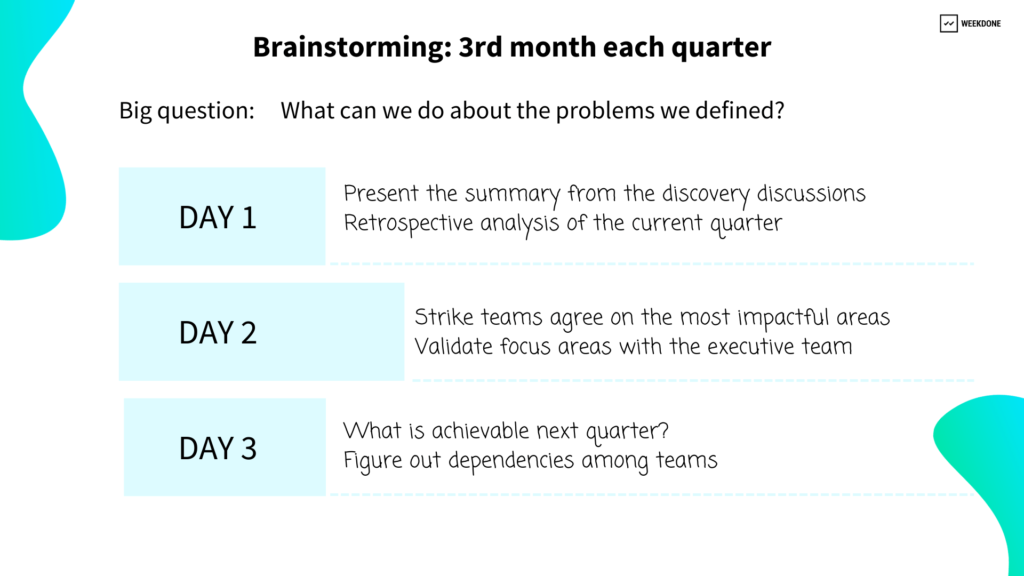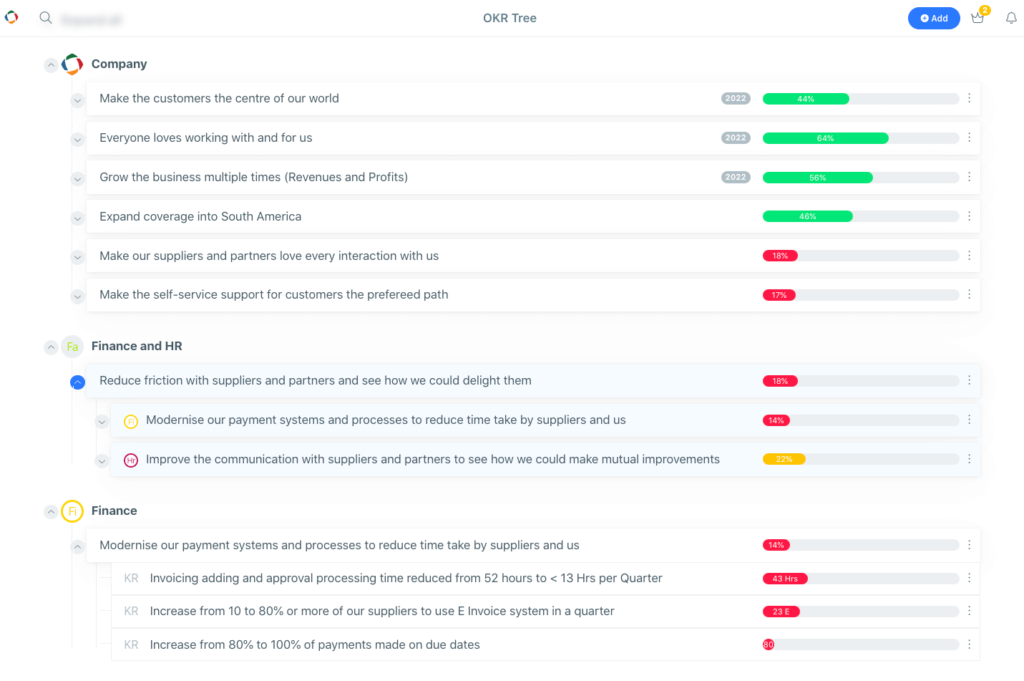Answering the hard questions about Objectives and Key Results
In order to know how to run and improve your business, you need to find the right things to measure, and that’s it. Or is it?
More and more articles out there are talking about the monstrous effort required to write good Key Results to Objectives. And, interestingly, a lot of those tips are missing one crucial insight.
If you haven’t figured out the right problem to solve, you are not likely to find the right things to measure. So the real roadblock is often not the Key Results, it’s the Objectives.
When writing OKRs, the first question should be not which metrics to throw together to track progress but what is the problem you are solving and why it is important right now.
In this second part of our case study interview with Ulysses Diaz – the Director of Program management in Reflex Media – we discuss the process of writing Company and Team level Objectives.
Here is what you will read about:
- How to organize engaging planning sessions?
- How many meetings should we have and who should participate?
- What is the difference between a planning discussion and a retrospective review discussion?
Read Part 1 of this case study: How OKRs can make a company stronger
Read some Company Objective Examples from Ulysses himself
Long Term vs. Short Term Planning
Do you plan annually or quarterly?
We do year-end planning where we talk about the vision for the following year. That discussion sets the precedent and “the web” for the conversations for the quarters to come.
The purpose of the annual planning is not to discuss what is going to be done each quarter but to decide on the big directions that we are going to deal with.
It’s important to set the intention in terms of timing. If you know that you are going to do something huge in Q3, you don’t have to give me the dates but we need to know that you want to do it in Q3.
That way, if there is any pre-work or any conversations that need to happen in Q2, we can get that out of the way. And then when we get to Q3, we know what we are doing and we hit the ground running.
For the annual discussion, I just give the teams these 4 quadrants of the year and ask to think through the general expectations on what is going to be happening each quarter.
Corporate level Objectives
What does executive level planning look like?
The whole process starts with setting annual expectations. In October, we do planning for the upcoming year – so we lay out our strategy and we look at where we want to be at the end of the coming year.
And in the second month of every quarter, I sit down with my executive team and we look at the plan that we laid out in October and analyze our current quarterly progress. That gives us an understanding of what needs to change in the following quarterly cycle.
We look at our focus areas, our gaps, anything we need to solve. For example, if our acquisition stats are starting to flatline, what do we need to solve for acquisition? What are the bright spots, what is working well and what is not working well?
We would try to look at our acquisition efforts as a whole. This discussion is just me and the COO but we are going into that discussion with inputs from all of the teams – not doing it in a vacuum.
It takes us roughly 45 minutes as long as we go in prepared. That’s why all of those inputs are necessary. If I go in after I do my due diligence, it could be even 30 minutes.
I try to do things as simple as possible. I take a focus area and I get it condensed down to one word. So if that one word is acquisition, that’s the only thing we are going to talk about.
When do you involve the department managers in this discussion?
I take the conclusions from the executive meeting and I bring them to the “strike team” discussions. The strike teams are just detachments of specialized roles. This is from my military background.
To create a “strike team”, I look at our organization and pick the specialists in the areas that need to be a part of the conversation. So if it’s something that is specific to acquisition, I know that I need my Digital Marketing team there and Marketing in general because they will need to develop the assets so that we can advertise.
I will also invite the Data team to make sure that we will have the analytics that we need, and so that they are in the room in case we need to build some new capabilities.
To get those discussions going, I need a clear understanding of the aspect of that general topic that we need to focus on: if it’s acquisition, then what about it? Are we innovating, are we fixing a particular problem, are we building something from the ground up?
Discussions with strike teams take me about an hour and a half, and I go in with the questions, with a specific agenda, specific topics to discuss.
So people talk, brainstorm, and I listen, observe and take notes. In the meantime, I compartmentalize the conversation by department so that I know – this is what Digital said, this is what Marketing said, this is what Data said.
During the conversation, I would sometimes intervene, and say – okay guys, remember the outcome that we are working towards is for you to leave this discussion with an understanding of what your Department level Objective will be in support of the corporate level Objective, and what the KRs will look like as you are trying to break things down for your teams.
Throughout the entire conversation, I am constantly bringing them back to the framing of Objectives and Key Results. So we can have these multi-hour long discussions but I need them to take this information and distill that into departmental outcomes that are going to feed into the corporate Objective.
As we get to the end of the conversation, I’ll go through a quick recap and try to concisely express what each department was talking about. So the summary roughly looks like this:
- this is what you were talking about,
- this is why,
- this is how it ties into other teams.
Those summaries often become drafts for the departmental Objectives. And then we start talking about Team OKRs. What are they going to do? How are we going to measure success in this focus area?
🎯 Side Note: In companies with 100+ employees, there might be 3 levels for Objectives - Company, Department and Team. Department level Objectives are overarching directions for the teams that belong to that department. Smaller companies often stick to the 2 levels for Objectives - Company and Team.
Once we have some ideas for Team OKRs, I compartmentalize this into action items that become a starting point for the quarterly planning discussion of functional teams.
On top of those strike team discussions, we need to factor in our current progress on OKRs, and where we are going to finish the quarter. At this point we reach the beginning of the third month within a quarter, and it’s time to write actionable OKRs and decide on the immediate priorities.
From Company level to Department level
How do you move on from discussions to actual planning?
When it’s time to write Objectives for different departments, we split this process into several days.
Day 1
Day one is a retrospective, then looking into the summary from the strike team discussions, and analysis of this quarter’s achievements.
When we do our retrospectives, we are using a very common and very simple framework. We go through these questions:
- What went well?
- Areas to improve?
- What are the action items?
- Any open questions?
We do it with team managers only but it’s done cross-functionally. Because there are a lot of differences in opinions, and this is a good time and place to discuss those because a lot of grievances are aired out organically with people being in the same room.
We also talk through any challenges that are not specific to any project or initiative that we are doing. These challenges might be connected to Covid, or remote work, or inflation and how people are feeling because of it.
Day 2
On day two, we take the input from the team retros and go back to our strike team discussions. That is a focused working session around each Department Objective.
The strike teams are made up of the subject matter experts. So that could be anyone of any level of the company – what we are looking for is insight, experience and creativity.
Let’s say our departmental level focus is acquisition, and we want to make sure that we are not flatlining on our growth and we are looking at other channels that we have not currently tapped into for acquisition.
So I’ll phrase a lot of questions around it: What are the channels that we are currently not using? What are some of the challenges that we had last quarter? What are some creative ways to improve the situation?
I would think of some of the tools that we already have in place and I would ask whether we are using those properly. Are there any gaps within our strategy with these tools?
The quality of the planning process always goes back to the champion, whoever is leading the OKR process in the company, as you should ask a lot of open-ended questions that get the team started.
If we want to compartmentalize that further, it really boils down to 2 questions: what do we currently have in place and is there anything we can improve upon? And then, let’s get innovative. What are the things out there that we could be doing that we are currently not doing.
So within those three subsets, we start getting into the specific actionable ideas, figuring out what we need to do, what we need to put in place to get there.
Because we’ve worked the process so much, I have the teams trained to start thinking of the answers to questions that I’m asking in the frame of a high-level KR (lower level Objective).
So I tell them what is most likely going to be a Company level Objective – at this stage, the wording is not final, and I will wordsmith it, make it pretty towards the beginning of the quarter. As we are thinking through things, employees are giving me responses to some of the problems that we have – and I help summarize these responses in the form of C level KRs that will turn into Department level Objectives.
Putting the team in this mindset allows me to get very clear and concise answers from each Department. So I have a clear picture of what Digital Marketing is going to do, what IT is going to do, what the Data team is going to do, and then we use those as starting points to develop Team level OKRs.
To finalize the ideation process, I would usually have all of the department heads, all leadership, all executives in one room for one final discussion per Department Objective. We come to the end of the discussion having figured out what different departments are going to do in specific support of this corporate level Objective, and we would know the exact outcomes that we are driving towards within these corporate level Objectives. That’s the end of Day two.
Day 3
On day 3, we come back to team specific discussions, look into the departmental focus and figure out any dependencies so that we can map them out cross-functionally.
On this day, I also like the teams to go through this exercise that I call “love to have”. I just tell them – okay, in the quarter that’s coming up if we could just get a magic wand and get whatever we wanted, what would that look like?
I’ve gotten things from bean bags in the auditorium to “we’d love it if an ice-cream truck came to the office every month”. Little things like that. Other times it’s been like – we really need more resources, and I’d love it if we could hire 2 or 3 more people. So it could really be anything.
And then we wrap it up with a retro of the actual planning process itself. To figure out what we can do better next time.
By that time, we’ve finished our strategy discussions, we have our corporate level Objectives solidified, and each Department has a very clear understanding of what they are going to do for the quarter. At this point, I give the department managers about a week to wordsmith the Departmental Objectives, and then we kick off the team specific build-out of OKRs.
From Department level to Team level
How do the teams go about driving Department Objectives forward?
Let’s say, a Marketing Department would have their general Departmental Objective, and they would go through an exercise with the teams that belong to that department. The exercise is very similar to what we do on Day two of our departmental planning process.
They would look at their overarching focus (Department Objective, in this case) – and ask: what is the Creative team, Production team, etc. going to do to support this?
I give the teams the rest of the month (third month of the quarter) to figure that out and finalize their OKRs.
OKR process for Development Teams
Is the OKR process any different for development teams?
While most of the company is in Las Vegas, all of our technical teams are in Singapore. And I kick off the planning process with them once the US teams are working on finalizing their OKRs.
I have developed a method with them where everything that is captured in Weekdone is only 20% of their bandwidth. The majority of their time and energy is spent supporting the core product initiatives and specs.
So 80% of their time is materialized through the successful implementation of whatever is in the Product OKRs. And the other 20% of their time are their own improvement ideas.
With them we do the planning within 2 days, and a lot of it is very similar: we do the retro, we look at the current progress, and where we would end the current quarter. Then we look at the product roadmap and talk about process optimization because a lot of the harmony that needs to be achieved between Singaporean and Las Vegas teams comes from cross-collaboration. There are issues like working in different time zones. So processes are very important with that team.
When looking at the product roadmap, we discuss each individual initiative at a very high level to talk through anything that sticks out.
For example, one of the features that we are going to roll out requires us to have numerous conversations about building an algorithm so we need to talk about it.
We start to set the intention at a high level for each of the features and then we wrap up, and do a retro about the planning process itself.
And at that point, usually in the following week, everything would be finalized – from all teams, and we would have one last consensus building meeting on the OKRs for the coming quarter.
Presenting OKRs to the leaders
What is the consensus building meeting?
Once next quarter OKRs are finalized, we present them to the owner of the company.
In that meeting, we will have all of the team leads, all of the department heads, and anybody who needs to be there for the presentation. This is our “speak or forever hold your peace” moment.
We don’t go through every granular KR but we reiterate very clearly what the Objectives are, what we are driving towards, how each team is going to support that. So if anybody is like “whoa, that does not match with what I’m thinking I need to do” or “we missed this thing and it’s extremely important”, that’s the last opportunity to bring that up. And then we go into the quarter.
Challenges in the OKR process
Did you ever get stuck in this process with the team?
We had instances when we didn’t have base lines for KRs prior to the discussions but that was the only point when a team could get slightly stuck or sidetracked.
There has never been a question that was so impairing that we couldn’t move forward. If anything, the only thing that would be slowing us down is teams having a hard time understanding how the Objectives turn into KRs that turn into other Objectives that break down into KRs again. That was the part where people could get stuck.
Right now there are no hiccups in this process, and it’s really clockwork. I don’t even have to tell the teams when I want their OKRs.
It took 2 and half years to get to this clockwork process. We have around 140 people in both Las Vegas and Singaporean offices, and a total of 170 people if I count our office in Ukraine.
Everyone now is following this process. Everyone new who joins the company goes through our internal training to understand how everything connects together. When I just explain it in theory, it sounds crazy confusing – but they just need to do it once, and they will be on board.
I tell them that I will be with them every step of the way, and they can ask any questions. It’s learning by practice. Now, I am also building out a shared knowledge database in Confluence where I am writing out all of these processes. I will have it all in one sheet at some point.
And, the best thing is, we can grow as a company and hire more people, and this process will still be sustainable and work as long as we need. As long as there is someone facilitating the discussions and supporting the teams.
In the Part 3 of this case study interview – Company Goals Examples – Ulysses shares real Company Objectives to illustrate how the OKR process helps with strategy validation and focused execution.





